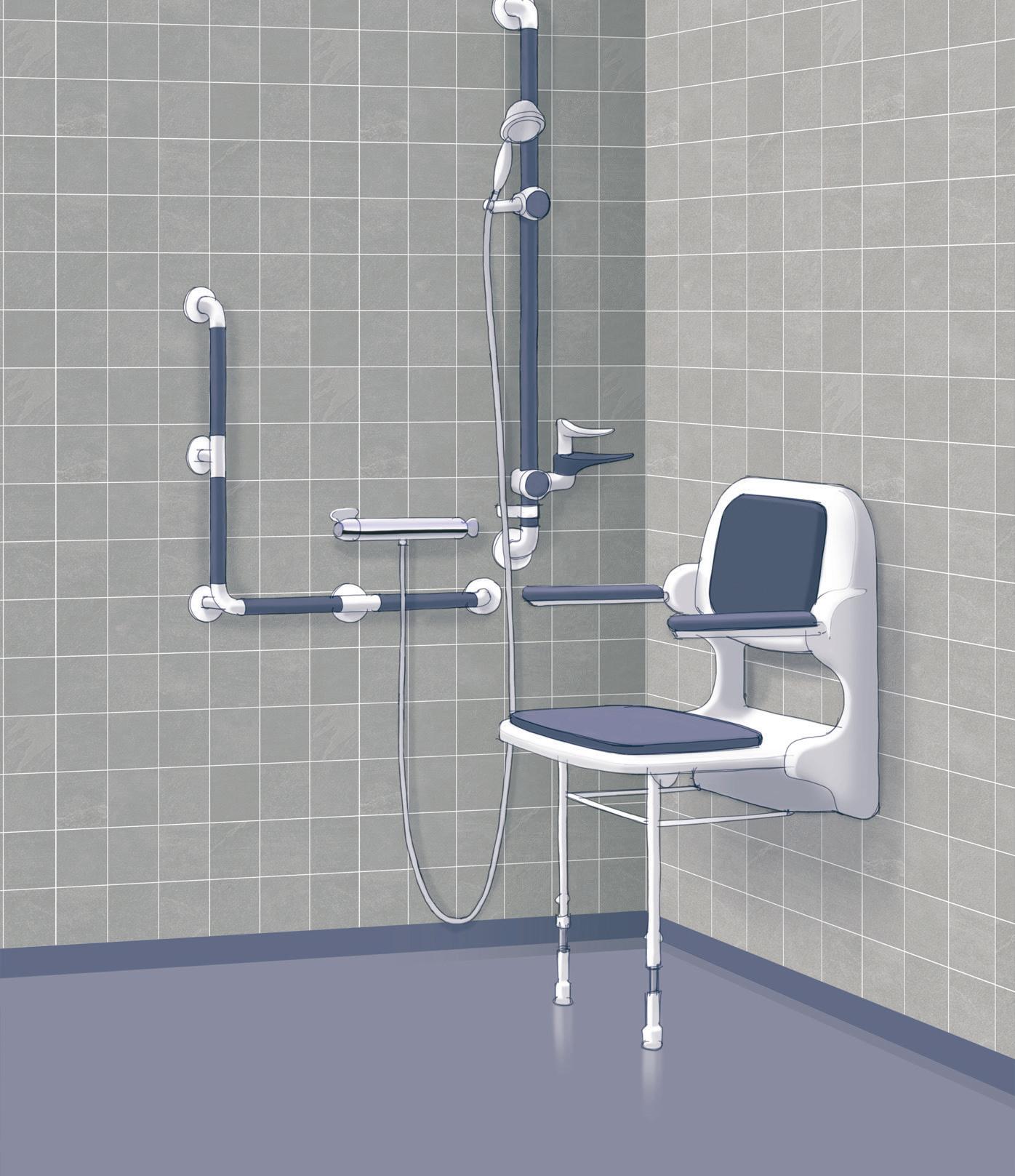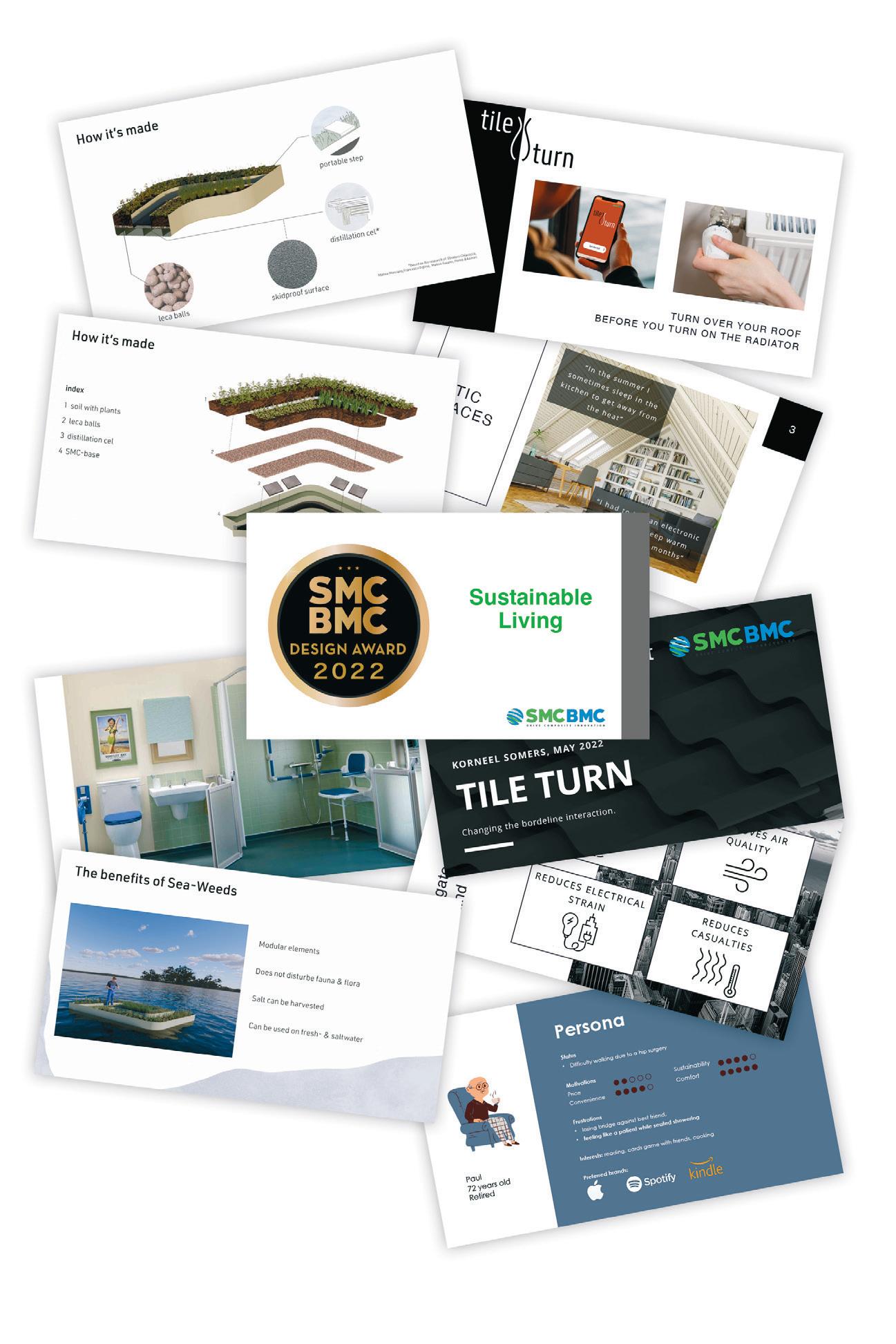SUSTAINABLE LIVING WITH SMC BMC

Isa Buitenhuis, an Industrial Design Engineering student at Delft University of Technology in the Netherlands, won the Gold Award in the 2022 SMC BMC Design Award. The competition’s theme was Sustainable Living and Isa’s LightTurn seated showering concept aims to improve the quality of life of elderly people, whilst also encouraging reduced water and energy consumption. Here, Isa discusses her winning design, her future plans, and her experience of taking part in the competition.

THE INSPIRATION
“We are currently facing an ageing population in Europe and most of them live at home or with their family, so that created a group for me that was in need of a product to support their quality of life at home,” Isa explains. “I chose a design direction ‘sustainable health in the bathroom.’ At the same time, we are living in a world where water scarcity is a problem that must be dealt with. One shower consumes 70 litres of water and an efficient solution to showering could bring huge benefits.”
A survey confirmed that her target group viewed traditional shower seats as visually unattractive –making them feel like a patient – and not well suited to a home environment. Isa wanted to create a stylish, comfortable solution that offers a more enjoyable experience, and at the same time reduce water consumption by making the user more aware of their showering behaviour.
With the insights from her analyses and interviews Isa set to work on her ideas, made a lot of sketches, and eventually narrowed down the various concepts to one.
“Then I moved further with that, and defined all the functions and the parts, and focused on the details of the design. I also thought about the implementation: how are we going to take this to the market, and who can be an interesting partner to collaborate with?”
Current solutions for seated showering are practical but very unattractive.

SMC/BMC Design Guide 3
The idea for LightTurn was sparked by a trends analysis
THE DESIGN
The LightTurn combines a shower head, shower chair, lighting system and electrical interface in one product. There are three SMC parts: the shower head (A), the chair (B), and the supporting lower side (C). The mounting plate to fix the product to the wall could also potentially be made from SMC, Isa notes.
The consumer can choose the combination of parts A and C, or A and B. For example, a 40-year-old consumer might buy the LightTurn as a stylish addition for their bathroom, with part C providing a useful shelf. Around 30 years later they might prefer to sit while showering and the LightTurn can be converted into a shower chair by replacing part C with part B.


The chair incorporates cushions for greater comfort and to prevent slipping, as well as a hand shower for extra convenience. An opening at the back of the chair allows water to exit. Part C could be returned to the manufacturer for reuse in another application.

2 SMC/BMC Design Guide 3
The modular design of the LightTurn means it can be adapted to the user’s needs over time.
The LightTurn also helps the user to reduce their water and energy use, saving them money.
The water-saving shower head is fitted with LED lighting which turns green to indicate when the water is the desired temperature. After 5 minutes of showering the light turns yellow to prompt the user to finish. The electrical interface will display useful information such as water temperature and showering time. It could also be possible to present data on how much energy is used during a shower, and how much this costs.

“I chose SMC because it is so strong and stiff, and because the material is so long-lasting and you can use it for 20+ years. That is a really strong benefit. It also has a smooth surface which is easy to clean.”

The Design Award jury praised Isa’s design for its creativity and for addressing true consumer needs. They also envisioned that it would be feasible to manufacture in SMC and could be successfully commercialised.

SMC/BMC Design Guide 3
3
Durability was a key factor in Isa’s choice of materials for the LightTurn since the product is intended to have a long service life.
User scenario.
THE ROUTE TO MARKET
As winner of Gold Award, Isa received €7,500 in coaching from Alliance members to help fine-tune her design, explore how it could best be manufactured, and strengthen her business plan. This support included a workshop, where Isa had the opportunity to discuss her concept with SMC experts.

The choice of SMC and the importance of highlighting its benefits over alternative materials was one consideration. Isa is also thinking about improvements to the shape of the parts. The chair, for example, is very ‘sharp’ and a curved design could offer more comfort.
“This is of course a concept and it’s really about functionality. I think the challenge in designing a chair is you want an aesthetic shape of course, but you also need to think about the ergonomics and you also need to think about comfort. Also, the manufacturing of the parts needs to be reviewed at the design stage. I think finding a balance between those factors is a good challenge that I still need to look at.”
As a luxury product, the LightTurn’s appearance has to be maintained over a long period of time and it must be possible to clean it easily, without scratching the surface or changing the colour.
“We talked in the workshop about some coatings. I think that could be very interesting for maintaining the quality of the product for many years. We also discussed the cleanability and the possibility of an anti-bacterial layer.”
The manufacture of the product was examined in detail, and especially the mould, which is a major contributor to production cost. Part A and B could potentially be made in one step, but due to considerations such as tool costing and process cycle times it may be easier and more cost-effective to mould separate components. The mould surface also needs careful consideration to ensure that the surface of the final part is attractive yet easy to clean.
Accelerated ageing tests and other studies to compare different surfaces and coatings would indicate how cleaning affects the finish and how calcium carbonate deposits from hard water build up on the surface over time.
The best way to integrate the SMC parts with the electrical components also needs to be determined. Alongside these design and manufacturing aspects, the business plan was discussed, including the need for a detailed analysis of the LightTurn’s potential buyers and their decision making process.

SMC/BMC Design Guide 3
4
Isa outlines her next steps.
“The most important one is looking again at the shape of the chair, and also thinking about how we are going to manufacture it, looking at the mould design, looking at the cost. I just had a course about setting up a business model so I think it’s nice to use that knowledge. I think it’s also nice to rephrase the value proposition a bit – what is the USP of this product, what are the functionalities that brings to the user?”
The Alliance will continue to collaborate with Isa to help her finalise the design, legally protect it, and ultimately assist her in presenting her concept to potential manufacturers.
A VALUABLE EXPERIENCE FOR YOUNG DESIGNERS


Isa and the other Design Award finalists presented their projects during a special conference session at JEC World 2022 in Paris and she received her prize at an awards ceremony later that day.
“It was a lot of fun, and I learned a lot from it. I had an amazing time in Paris. I had a lot of fun with the other participants, and on the day itself it was super-cool to see all the big players of the composites market and be able to speak with them.” She also found the workshop a valuable introduction to the reality of the industrial world.
“It was really nice to dive in a little bit deeper on some aspects, because I’m just a designer who likes to sketch and come up with ideas. In my Bachelor’s and also now in my Master’s in Industrial Design Engineering you get an idea and you work on that, but it’s only 10 or 20 weeks and then it’s done. You never get to the point of the workshop where you really look at the reality and the real market. It was really interesting and insightful.”
“This experience is also very useful for the rest of my studies, as nowadays I have to pitch a lot. We’re going to real clients to show them our ideas, and something I also learned from the workshop is you really have to come up with convincing product benefits and arguments for the design choices made, because that’s what clients want to see.”
SMC/BMC Design Guide 3 5
SMC/BMC Design Guide 3
THE SMC BMC DESIGN AWARD


Sheet moulding compound (SMC) and bulk moulding compound (BMC) are fibre reinforced polymers, also known as composite materials. They consist of a thermoset resin (typically an unsaturated polyester), a fibre reinforcement, an inorganic filler, and various additives designed to improve processability and performance. Formulations can be tailored to deliver specific properties in the final product, such as fire resistance.
Because of its longer fibre length, SMC has greater flexural and tensile strength than BMC. It is ideal for the manufacture of fairly intricate parts which combine structural performance with a smooth finish. SMC and BMC are converted into components using cost-effective compression moulding and injection moulding processes. Production volumes of more than 1 million parts/year are achievable using these highly automated, industrial processes.
Organised by the European Alliance for SMC BMC, the SMC BMC Design Award recognises and rewards design excellence in SMC BMC materials. It is intended to increase awareness of SMC BMC among young designers and demonstrate that SMC and BMC are innovative, versatile and cost effective materials which can be used to create products offering significant benefits to individual consumers and to society.
The competition is open to design students, and design professionals with less than three years of experience, living in Europe. Entries are judged by a jury of experts from the design and composites communities against the four key criteria: creativity, end-user functionality, sustainability, and feasibility in SMC BMC. The winner of the Gold Award receives €7,500 in cash and €7,500 in coaching , the Silver Award winner receives €1,500, and the Bronze Award winner €1,000.
The
European Alliance for SMC BMC Sector Group

Disclaimer
info@smcbmc-europe.org
March 2023
6
This article is intended for general information only, and whilst its contents are provided in good faith it is to be relied upon at the user’s own risk. No representations or warranties are made with regards to its completeness or accuracy and no liability will be accepted by the authors. of EuCIA
Blvd. A. Reyers 80 1030 Brussels Belgium
www.smcbmc-europe.org
Copyright The European Alliance for SMC BMC












